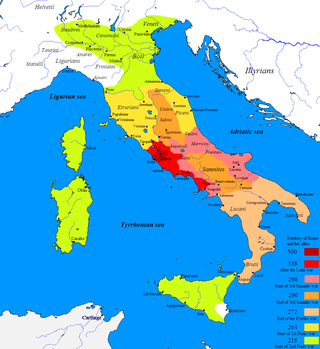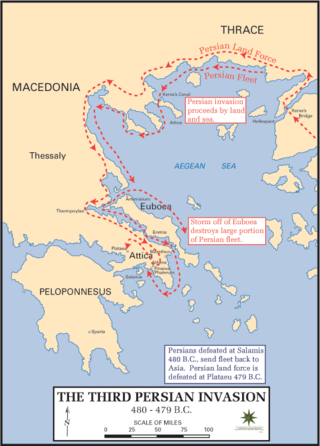Related Research Articles

Syracuse is a historic city on the Italian island of Sicily, the capital of the Italian province of Syracuse. The city is notable for its rich Greek and Roman history, culture, amphitheatres, architecture, and as the birthplace and home of the pre-eminent mathematician and engineer Archimedes. This 2,700-year-old city played a key role in ancient times, when it was one of the major powers of the Mediterranean world. Syracuse is located in the southeast corner of the island of Sicily, next to the Gulf of Syracuse beside the Ionian Sea. It is situated in a drastic rise of land with 2,000 metres (6,600 ft) depths being close to the city offshore although the city itself is generally not so hilly in comparison.

The 5th century BC started the first day of 500 BC and ended the last day of 401 BC.
Year 481 BC was a year of the pre-Julian Roman calendar. At the time, it was known as the Year of the Consulship of Vibulanus and Fusus. The denomination 481 BC for this year has been used since the early medieval period, when the Anno Domini calendar era became the prevalent method in Europe for naming years.

Year 264 BC was a year of the pre-Julian Roman calendar. At the time it was known as the Year of the Consulship of Caudex and Flaccus. The denomination 264 BC for this year has been used since the early medieval period, when the Anno Domini calendar era became the prevalent method in Europe for naming years.
This article concerns the period 479 BC – 470 BC.
This article concerns the period 469 BC – 460 BC.

Year 480 BC was a year of the pre-Julian Roman calendar. At the time, it was known as the Year of the Consulship of Vibulanus and Cincinnatus. The denomination 480 BC for this year has been used since the early medieval period, when the Anno Domini calendar era became the prevalent method in Europe for naming years.
Year 484 BC was a year of the pre-Julian Roman calendar. At the time, it was known as the Year of the Consulship of Mamercus and Vibulanus. The denomination 484 BC for this year has been used since the early medieval period, when the Anno Domini calendar era became the prevalent method in Europe for naming years.
Year 485 BC was a year of the pre-Julian Roman calendar. At the time, it was known as the Year of the Consulship of Cornelius and Vibulanus. The denomination 485 BC for this year has been used since the early medieval period, when the Anno Domini calendar era became the prevalent method in Europe for naming years.
Year 483 BC was a year of the pre-Julian Roman calendar. At the time, it was known as the Year of the Consulship of Vibulanus and Potitus. The denomination 483 BC for this year has been used since the early medieval period, when the Anno Domini calendar era became the prevalent method in Europe for naming years.
Year 215 BC was a year of the pre-Julian Roman calendar. At the time it was known as the Year of the Consulship of Albinus/Marcellus/Verrucosus and Gracchus. The denomination 215 BC for this year has been used since the early medieval period, when the Anno Domini calendar era became the prevalent method in Europe for naming years.
Year 257 BC was a year of the pre-Julian Roman calendar. At the time it was known as the Year of the Consulship of Regulus and Blasio. The denomination 257 BC for this year has been used since the early medieval period, when the Anno Domini calendar era became the prevalent method in Europe for naming years.
Year 478 BC was a year of the pre-Julian Roman calendar. At the time, it was known as the Year of the Consulship of Mamercus and Structus. The denomination 478 BC for this year has been used since the early medieval period, when the Anno Domini calendar era became the prevalent method in Europe for naming years.
Year 474 BC was a year of the pre-Julian Roman calendar. At the time, it was known as the Year of the Consulship of Medullinus and Vulso. The denomination 474 BC for this year has been used since the early medieval period, when the Anno Domini calendar era became the prevalent method in Europe for naming years.
HieronI was the son of Deinomenes, the brother of Gelon and tyrant of Syracuse in Sicily, from 478 to 467 BC. In succeeding Gelon, he conspired against a third brother, Polyzelos.

Hiero II, also called Hieron II, was the Greek tyrant of Syracuse, Greek Sicily, from 275 to 215 BC, and the illegitimate son of a Syracusan noble, Hierocles, who claimed descent from Gelon. He was a former general of Pyrrhus of Epirus and an important figure of the First Punic War. He figures in the story of famed thinker Archimedes shouting "Eureka".

The Mamertines were mercenaries of Italian origin who had been hired from their home in Campania by Agathocles, Tyrant of Syracuse and self-proclaimed King of Sicily. After Syracuse lost the Seventh Sicilian War, the city of Messina was ceded to Carthage in 307 BC. When Agathocles died in 289 BC it left many of his mercenaries idle and unemployed in Sicily. Most of them returned home but some, liking the climate and the prospect of adventure on a foreign island, remained. They played a major role in the lead-up to the First Punic War.
Hiero or hieron is an ancient Greek shrine, temple, or temple precinct.
Anaxilas or Anaxilaus, son of Cretines, was a tyrant of Rhegium in Magna Graecia. He was originally from Messenia, a region in the Peloponnese.